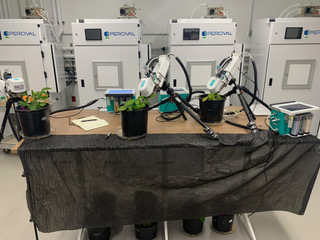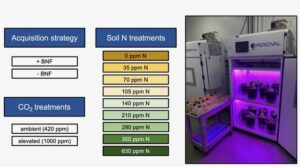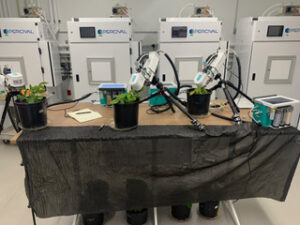As atmospheric CO₂ levels continue to rise, understanding how plants respond to elevated CO₂ (eCO₂) is crucial for predicting the future of ecosystems and global carbon cycling. A long-standing debate in plant ecology centres around whether nitrogen supply or nitrogen demand primarily regulates plant responses to eCO₂. A new study, published this month in the Journal of Experimental Botany by LEMONTREE researchers Evan Perkowski, Zinny Ezekannagha, and PI Nick Smith from Texas Tech University’s PhUnFETTy Lab sheds new light on this question.
Using a full-factorial experiment, the research team explored how nitrogen demand, nitrogen availability, and nitrogen acquisition strategies influence plant responses to eCO₂. Their findings provide strong support for eco-evolutionary optimality (EEO) theory, showing that leaf-level photosynthetic responses to eCO₂ are driven by nitrogen demand rather than availability, while whole-plant responses remain constrained by nitrogen supply. These results help resolve a long-standing ecological question and enhance our understanding of how plants will acclimate to rising CO₂ levels in the future.
A Growth Chamber Experiment to Test Nitrogen’s Role in eCO₂ Responses
To understand the effects of nitrogen on plant responses to eCO₂, the team conducted an experiment using soybean seedlings grown under tightly controlled growth chamber conditions. They designed a full-factorial experiment with:
- Two CO₂ levels (ambient and elevated)
- Two inoculation treatments (presence or absence of nitrogen-fixing bacteria)
- Nine nitrogen fertilization levels
This setup allowed the team to isolate and examine how different nitrogen acquisition strategies (direct uptake through fertilisation vs. biological nitrogen fixation) influenced plant acclimation to eCO₂.
Experimental set-up. Schematic of experimental set up (left), experimental setup with plants growing in each condition nitrogen and CO2 conditions (middle) and gas exchange measurements being taken (right).
Key Findings
1) Leaf-Level Responses Are Driven by Nitrogen Demand
One of the most significant findings was that leaf-level photosynthetic responses to eCO₂ were not affected by nitrogen fertilisation or inoculation treatments. Instead, plants exhibited acclimation responses consistent with EEO theory, whereby plant physiological adjustments occur to optimise resource use efficiency.
Specifically, under eCO₂:
- The maximum rate of Rubisco carboxylation (Vcmax) decreased more than the maximum rate of electron transport for RuBP regeneration (Jmax).
- This shift allowed photosynthetic rate-limiting steps to approach optimal coordination, leading to increased net photosynthesis under growth CO2 conditions.
- These patterns suggest that leaf nitrogen demand for building and maintaining photosynthetic enzymes regulates photosynthetic acclimation, independent of nitrogen availability.
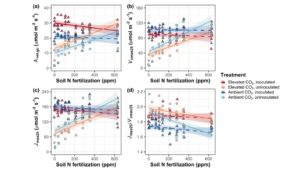
2. Whole-Plant Responses Are Constrained by Nitrogen Availability
While nitrogen availability did not affect leaf-level photosynthetic responses to eCO2, it did enhance whole-plant responses to eCO₂. Increasing nitrogen fertilization led to:
- Greater belowground carbon allocation
- Increased nitrogen uptake
- Enhanced biomass production under eCO₂
- Increased total leaf area and total plant nitrogen
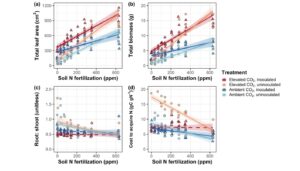
These findings align with previous research showing that nitrogen limitation constrains whole-plant responses to eCO₂. In other words, while photosynthetic adjustments at the leaf level follow least-cost theory and optimal coordination principles, overall plant growth is still dependent on nitrogen availability.
What About Nitrogen-Fixing Bacteria?
A surprising result from the study was that inoculation with nitrogen-fixing bacteria had no effect on either leaf- or whole-plant response to eCO₂, even under low nitrogen conditions where plants had the highest investment in symbiotic nitrogen-fixing bacteria. While inoculation did increase root nodulation under eCO₂, it did not significantly enhance whole-plant responses. This suggests that when whole-plant nitrogen demand for building new tissues rises, plants may prioritize direct nitrogen uptake pathways over symbiotic nitrogen fixation as a strategy to avoid co-limitation by other nutrients, such as phosphorus.
This work helps resolve the longstanding question as to whether nitrogen supply or demand drives plant responses to eCO2, showing that nitrogen demand regulates leaf-level responses to eCO2 and nitrogen supply constrains whole-plant responses. I am super proud of the work and am glad it’s finally out for all to read and engage with!
Dr Evan Perkowski, lead author
Resolving the Long-Standing Debate
This study provides strong empirical support for EEO theory by demonstrating that leaf-level responses to eCO₂ are dictated by nitrogen demand, whereas whole-plant responses are limited by nitrogen supply.
These findings challenge traditional perspectives that nitrogen availability is the primary driver of plant acclimation to eCO₂. Instead, they suggest that plants optimize resource use in response to changing environmental conditions, balancing carbon and nitrogen investments to enhance photosynthetic efficiency and growth.
Key questions for future research
- How do these patterns hold across different plant species and ecosystems?
- What role does nitrogen cycling in soils play in modifying plant responses to eCO₂?
- How do long-term acclimation processes shape plant adaptation to future climate scenarios?
- Do we observe similar patterns in response to changing phosphorus availability?
Implications for Ecosystem and Climate Models
A key takeaway from this study is that terrestrial biosphere models may improve simulations of photosynthetic responses to rising CO₂ by incorporating optimality principles. The differential role of nitrogen demand and availability in regulating leaf- and whole-plant responses suggests that models should account for dynamic leaf nitrogen-photosynthesis relationships, optimal coordination of photosynthetic processes and the role of nutrient co-limitation (e.g., phosphorus) in plant responses.
For more details, check out the full paper:
Perkowski EA, Ezekannagha E, Smith NG. In press. Nitrogen demand, availability, and acquisition strategy control plant responses to elevated CO2. Journal of Experimental Botany. DOI: https://doi.org/10.1093/jxb/eraf118

